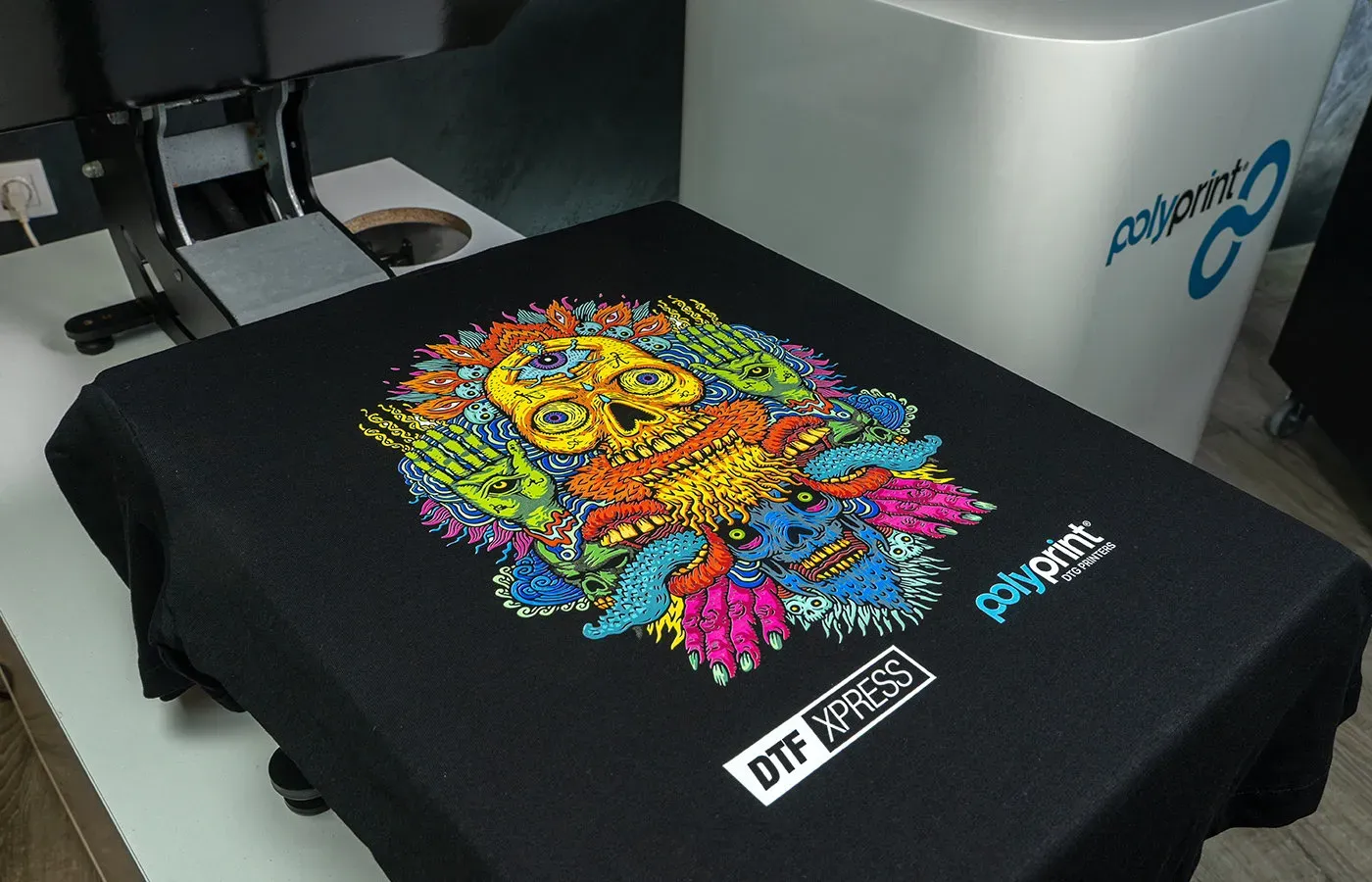DTF printing, or direct to film printing, has quickly become a game-changer in the world of textile production, allowing for intricate and vivid designs to be transferred onto a variety of fabrics with ease. This innovative printing technique provides unparalleled versatility, making it an ideal choice for personalized printing solutions, whether for apparel, home decor, or promotional merchandise. As the market for fabric printing continues to grow, DTF printing innovations are leading the charge, enabling creators to experiment with colors and patterns that stand out. The adaptability of DTF transfer methods means that businesses of all sizes can now tap into demand for unique, high-quality products. This comprehensive guide will explore the mechanics, benefits, and latest advancements of DTF printing, helping you unlock new creative possibilities.
When it comes to modern textile printing techniques, direct-to-film methods have garnered significant attention for their effectiveness and ease of use. Utilizing a state-of-the-art film transfer process, this approach to printing not only enhances the quality of designs but also streamlines the production of customized items. This innovative technology allows artists and businesses to produce eye-catching prints that can withstand the wear and tear of regular use. As DTF printing continues to gain momentum, industry players are increasingly focused on expanding its accessibility, offering new options in fabric printing that cater to the unique demands of consumers. With the rise of DTF transfer among crafters and small businesses alike, this printing solution reinforces the growing trend of personalization in the market.
Exploring the Mechanics of DTF Printing
DTF printing, or direct to film printing, is a sophisticated technique that has transformed the way designs are applied to fabrics. This process begins with printing your desired design onto a special film using innovative ink technology, which ensures vibrant colors and sharp details. After the design is printed, it is coated with a hot-melt adhesive powder before being transferred to the fabric using heat and pressure. This technique is versatile and can be applied across various materials, including cotton, polyester, and blends, making it an optimal choice for producing customized apparel.
Moreover, what sets DTF printing apart from other methods, such as screen printing and direct-to-garment (DTG), is its ability to reproduce intricate designs without the need for extensive pre-treatment of the fabric. This results in reduced production times and lower costs, particularly for small batches or personalized prints. With DTF printing, entrepreneurs can leverage this technology to offer unique designs that cater to individual customer preferences, driving engagement and sales.
DTF Transfer: The Game Changer in Textile Printing
The rise of DTF transfer technology has marked a significant advancement in the textile printing sector. This method allows for a simplified workflow compared to traditional printing techniques, making it accessible for those new to the industry as well as seasoned professionals. DTF transfers ensure that prints are not only aesthetically pleasing but also durable, standing up against repeated washing without losing their vibrancy.
Businesses can benefit greatly from the DTF transfer process due to its efficiency. With the capability to produce multiple designs in a short timeframe, print on demand has never been more viable. Companies no longer have to hold large inventories of printed items, thereby reducing costs and waste. As the market shifts toward more personalized and on-demand solutions, mastering DTF transfers can place businesses ahead of the curve.
By understanding the mechanics of DTF transfer printing, businesses can maximize their production efficiency and cater to the growing demand for customizable textile products. This shift towards personalization is not just a trend; it is indicative of customer preferences in today’s marketplace.
Innovations in DTF Printing Technology
In the ever-evolving world of DTF printing, technological innovations are pushing the boundaries of what is possible. New printer models are being developed that offer improved print speeds, higher resolutions, and more user-friendly interfaces, making DTF printing accessible to a wider audience. Innovations such as closed-loop ink systems and automatic film feeders are streamlining the printing process, enhancing operational efficiency and product consistency.
Additionally, advancements in ink formulations have improved adhesion and durability, ensuring that printed designs maintain their integrity even after multiple washes. These innovations reflect a broader trend in the textile printing industry towards sustainability and efficiency, paving the way for eco-friendly printing practices without compromising quality. Staying informed about these developments is critical for businesses seeking to invest in DTF technology.
Emerging Market Trends in DTF Printing
The DTF printing market is witnessing several trends that signal its growing relevance and potential. One notable trend is the increasing demand for personalized products. Consumers are increasingly seeking unique and customized items that express their individual style. Businesses that capitalize on this trend can foster customer loyalty and differentiate themselves from competitors through tailored offerings.
Furthermore, the shift towards sustainability has also influenced market trends, as brands look for printing solutions that minimize waste and reduce environmental impact. DTF printing, with its reduced setup time and ability to print short runs efficiently, aligns well with a more sustainable approach to manufacturing. Companies that embrace these market trends stand to gain a significant advantage in a crowded marketplace.
Educational Resources for DTF Printing Enthusiasts
As interest in DTF printing grows, so does the availability of educational resources designed to enhance understanding and proficiency in this technology. A plethora of online courses, video tutorials, and instructional articles are now accessible to newcomers eager to master the art of DTF printing. These resources cover everything from the basics of film selection and ink management to advanced techniques for troubleshooting and optimization.
Community forums and social media groups also provide invaluable support, allowing enthusiasts to share experiences, best practices, and advice. Engaging with these resources helps individuals build a strong foundation in DTF printing, enabling them to experiment and innovate in their projects. Whether for personal use or business expansion, accessing the right educational materials can significantly elevate overall print quality and efficiency.
The Future of DTF Printing: Opportunities and Challenges
Looking forward, the future of DTF printing appears bright with countless opportunities for growth and innovation. As technology continues to advance, businesses can expect further enhancements in printing capabilities, including the potential for integrating artificial intelligence and automation into the DTF workflow. This could lead to even faster production rates and a higher degree of customization than ever before.
However, with these opportunities come challenges. As more players enter the DTF printing space, competition will intensify, necessitating that businesses not only innovate but also differentiate their offerings in unique ways. Staying adaptable and responsive to market dynamics will be crucial for long-term success in this vibrant industry. DTF printing is at the forefront of the textile revolution, and those who engage with its potential will likely thrive.
Frequently Asked Questions
What is DTF Printing and how does it work?
DTF printing, or Direct to Film printing, is a modern technique that transfers designs onto a film, which is then applied to fabric using heat. This method allows for vibrant and durable prints on various materials like cotton and polyester, making it perfect for personalized printing projects.
What are the advantages of DTF transfer technology?
DTF transfer technology offers several advantages including the ability to produce high-quality prints with vibrant colors, versatility in fabric types, and durability, as prints can withstand multiple washes without fading. This makes DTF printing an attractive option for both commercial and personal applications.
How is DTF printing different from traditional fabric printing methods?
Unlike traditional fabric printing methods, such as screen printing, DTF printing allows for more intricate designs, quicker turnaround times, and the ability to print on a wider variety of fabrics. DTF also requires less setup time and is more cost-effective for short runs or small orders, enhancing accessibility for personalized printing.
What innovations are emerging in the DTF printing market?
Recent advancements in DTF printing innovations include the launch of compact, user-friendly A3 DTF printers designed for small businesses and freelancers. Companies like EazyDTF are increasing production capabilities with new large-format printers, ensuring rapid delivery for customized prints, which underscores the growing demand for efficient printing solutions.
Can DTF printing be used for commercial purposes?
Absolutely! DTF printing is gaining traction in the commercial market due to its ability to produce customized and high-quality prints efficiently. Services like Snuggle DTF cater to commercial print traders, making it a viable option for businesses looking to offer personalized products to their customers.
What resources are available for learning about DTF printing techniques?
There are numerous educational resources available for those interested in DTF printing. These include online articles, video tutorials, and webinars that cover essential topics such as the printing process, required materials, and troubleshooting tips. Engaging with these resources can help newcomers quickly gain practical knowledge in DTF printing.
| Key Points | Description |
|---|---|
| What is DTF Printing? | A method of transferring designs onto a film, which is heat-pressed onto fabrics, ideal for various materials like cotton and polyester. |
| Advantages of DTF Printing | Produces vibrant colors and durable prints that can withstand multiple washes. |
| Recent Innovations | Introduction of compact printers and enhanced production capabilities to cater to small businesses and on-demand markets. |
| Emerging Market Trends | Shift towards personalization and on-demand production with services tailored for commercial print traders. |
| Educational Resources | Access to videos, webinars, and articles helping newcomers understand the DTF printing process and techniques. |
Summary
DTF Printing represents a significant advancement in the world of textile printing, enabling both businesses and hobbyists to bring vibrant ideas to life with ease and precision. This innovative method has gained traction due to its versatility and ability to produce stunning prints on various fabrics. With the increase in educational resources and technology access, more individuals are empowered to leverage DTF printing for creative and commercial purposes. The industry’s growth signifies a powerful shift toward personalized and high-quality products, making DTF printing a pivotal force in modern textile applications.

